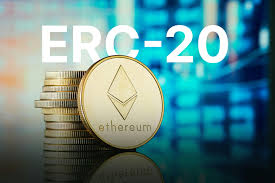ERC-20 Tokens
 Samuel Aleonomoh
Samuel Aleonomoh
Understanding ERC-20 Tokens: A Comprehensive Guide
The world of decentralized finance (DeFi) is built on the foundation of smart contracts, and one of the most prevalent types of smart contracts in the Ethereum ecosystem is the ERC-20 token. These tokens have become a de facto standard for creating fungible digital assets on the Ethereum blockchain. But what exactly are ERC-20 tokens, and how do they work? Let’s dive into the mechanics of ERC-20 tokens, breaking down the functions that make them tick, without relying on overly common or easily replicated phrases.
What is an ERC-20 Token?
ERC-20 is a technical standard used for smart contracts on the Ethereum blockchain. It defines a set of rules and functions that a token contract must follow, enabling it to interact with other contracts, applications, and wallets seamlessly. The standardization of these tokens has facilitated the creation and exchange of a wide array of digital assets, from stablecoins to utility tokens.
Core Functions of an ERC-20 Token
An ERC-20 token contract consists of several essential functions. These functions outline how the token behaves, how transactions are processed, and how balances are managed. Let’s explore each of these functions in detail.
1. totalSupply: The Token Inventory
The totalSupply function provides a complete picture of the total number of tokens that exist within the contract. It’s a constant function that returns the total supply of the token at any given moment.
Purpose: It helps to ensure that the contract does not create more tokens than intended, maintaining a cap on the token supply.
Example: If a token has a
totalSupplyof 1,000,000 units, this function would return 1,000,000.
2. balanceOf: Account Holdings
The balanceOf function is designed to query the number of tokens held by a specific account. This function takes an address as an input and returns the balance of tokens associated with that address.
Purpose: It allows users and other contracts to check how many tokens an address owns, enabling transparency and trust in the token system.
Example: If Alice’s address holds 500 tokens, calling
balanceOfwith her address would return 500.
3. transfer: Token Redistribution
The transfer function is the primary method by which tokens are sent from one address to another. It requires the sender to specify the recipient’s address and the amount of tokens to transfer.
Purpose: This function facilitates direct token transfers between users without requiring a third party.
Example: If Bob wants to send 100 tokens to Carol, he would call
transferwith Carol’s address and the amount (100).
4. approve: Allowance Authorization
The approve function is a bit more nuanced. It allows an address to authorize another address (typically a smart contract) to spend tokens on its behalf. The function sets a maximum amount that can be spent.
Purpose: This function is crucial for enabling smart contracts to interact with tokens on behalf of users, such as in decentralized exchanges.
Example: Dave approves a DEX contract to spend up to 200 tokens from his balance.
5. allowance: Checking Permissions
Complementary to approve, the allowance function checks the remaining amount of tokens that an authorized spender can still transfer on behalf of the token holder.
Purpose: It ensures that neither the token holder nor the authorized spender exceeds the agreed-upon limits.
Example: After Dave’s transaction, if the DEX has spent 50 tokens, calling
allowancewould return 150 (200 initially approved - 50 spent).
6. transferFrom: Delegated Transfers
The transferFrom function allows an authorized address to transfer tokens from one address to another, using the allowance set by approve. This function is commonly used in scenarios where a contract needs to move tokens as part of its operations.
Purpose: It enables more complex token interactions, such as automated payments or decentralized finance operations, without needing the token holder to initiate every transaction.
Example: The DEX contract uses
transferFromto move 100 tokens from Dave’s account to another trader’s account.
Events in ERC-20: Broadcasting Changes
In addition to these functions, ERC-20 tokens typically include events like Transfer and Approval. These events are broadcast to the network whenever a transfer or approval occurs, allowing external applications to track token movements and approvals.
TransferEvent: Emitted whenever tokens are moved from one address to another, providing details like the sender, recipient, and amount.ApprovalEvent: Emitted when an approval is set, broadcasting the owner’s address, the spender’s address, and the allowance amount.
Conclusion: The Backbone of DeFi
ERC-20 tokens have revolutionized the digital asset space by providing a standardized way to create, transfer, and manage tokens on the Ethereum blockchain. By adhering to the ERC-20 standard, developers ensure that their tokens can integrate seamlessly with the broader Ethereum ecosystem, including wallets, exchanges, and other smart contracts.
Understanding the core functions of ERC-20 tokens is crucial for anyone looking to engage with the Ethereum ecosystem, whether as a developer, investor, or user. These functions form the backbone of countless projects and use cases in the decentralized world, powering everything from simple token transfers to complex financial instruments.
As the blockchain space continues to evolve, the ERC-20 standard remains a cornerstone of the Ethereum ecosystem, enabling the proliferation of a wide variety of digital assets that drive the decentralized economy forward.
Subscribe to my newsletter
Read articles from Samuel Aleonomoh directly inside your inbox. Subscribe to the newsletter, and don't miss out.
Written by
